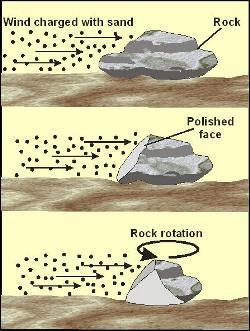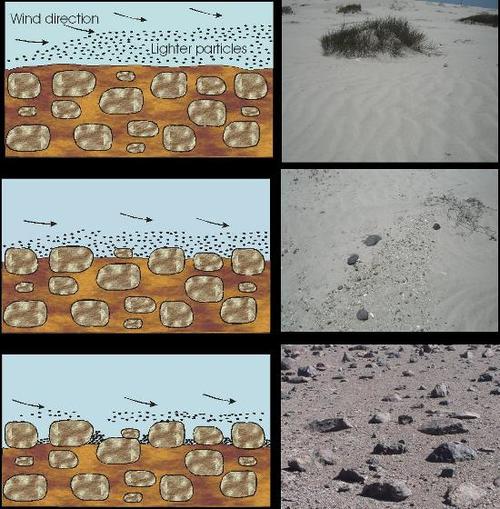Erosion and Wind Erosion
Ventifact produced by wind abrasion
Image Credit: MBG
The wind deflation process. Sand grains are removed, leaving heavier and larger grains behind
Image Credit: MBG
Erosion is defined as the set of natural processes that loosen, remove and transport weathered or unweathered solid material such as soil, sediment, mud, regolith, rock fragments and other particles from the landscape by downhill or downwind displacement.
The mediums required to for material displacement can be wind, running water, waves, ice (glaciers), underground water, and gravity.
As erosion moves weathered solid material, it exposes fresh, unaltered rock to weathering.
In some places, erosion is increased by human land use.
Wind erosion
Wind erosion is referred to as eolian erosion.
Differences in atmospheric pressure will cause the motion of air that can erode surface material when velocities are high enough to move particles.
Eolian erosion is more pronounced in dry regions and in areas where there is insufficient rainfall to support vegetation and root systems.
Wind cannot carry as large particles as flowing water, but easily pick ups dry particles of soil, sand and dust and carries them away.
Wind generally causes erosion by deflation and/or abrasion.
Wind breaks are often planted by farmers to reduce wind erosion.
Wind abrasion
Abrasion is the process of erosion produced by the suspended particles that impact on solid objects.
Windblown grains of sand, carried along at high speed, are a very effective tool that can sandblast away rocks by abrasion.
Wind deflation
Wind causes the lifting and transport of lighter particles from a dry soil, leaving behind a surface of coarse grained sand and rocks.
The removed particles will be transported to another region where they may form sand dunes on a beach or in a desert.



